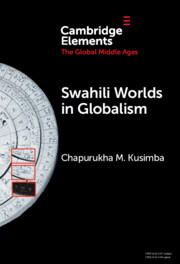126 results
27 - The Papal Wardrobe
- from Part IV - Education, Culture, Arts
-
-
- Book:
- The Cambridge History of the Papacy
- Published online:
- 28 February 2025
- Print publication:
- 20 March 2025, pp 748-770
-
- Chapter
- Export citation

Ladies-in-Waiting in Medieval England
-
- Published online:
- 02 January 2025
- Print publication:
- 09 January 2025
1 - Music and Mathematics in an Interconnected Web of Cosmic Relations
- from Part I - Context
-
- Book:
- The Science of Music
- Published online:
- 19 December 2024
- Print publication:
- 02 January 2025, pp 27-47
-
- Chapter
- Export citation
2 - Learning the Science of Music in Medieval Baghdad
- from Part I - Context
-
- Book:
- The Science of Music
- Published online:
- 19 December 2024
- Print publication:
- 02 January 2025, pp 48-72
-
- Chapter
- Export citation
Introduction
-
- Book:
- The Science of Music
- Published online:
- 19 December 2024
- Print publication:
- 02 January 2025, pp 1-24
-
- Chapter
- Export citation

The Science of Music
- Knowledge Production in Medieval Baghdad and Beyond
-
- Published online:
- 19 December 2024
- Print publication:
- 02 January 2025
The Anglo-Saxons: Myth and History
-
- Journal:
- Early Medieval England and its Neighbours / Volume 51 / 2025
- Published online by Cambridge University Press:
- 05 December 2024, e1
-
- Article
-
- You have access
- Open access
- HTML
- Export citation
Chapter 5 - Fighting the Good Fight
-
- Book:
- Masculinity in Byzantium, c. 1000–1200
- Published online:
- 07 November 2024
- Print publication:
- 21 November 2024, pp 129-156
-
- Chapter
- Export citation
Faith embodied: a tattooed individual from medieval Ghazali
-
- Article
-
- You have access
- Open access
- HTML
- Export citation
The Mortar Wreck: a mid-thirteenth-century ship, wrecked off Studland Bay, Dorset, carrying a cargo of Purbeck stone
- Part of
-
- Article
-
- You have access
- Open access
- HTML
- Export citation
Intestinal parasite infection and sanitation in medieval Leiden, the Low Countries
- Part of
-
- Article
-
- You have access
- Open access
- HTML
- Export citation
7 - Sex in Iceland in the Fourteenth and Fifteenth Centuries ce
-
-
- Book:
- The Cambridge World History of Sexualities
- Published online:
- 26 April 2024
- Print publication:
- 16 May 2024, pp 132-149
-
- Chapter
- Export citation
Pledging Lordly Rights and “Squeezing” Local Communities in the Later Middle Ages
-
- Journal:
- Austrian History Yearbook / Volume 55 / May 2024
- Published online by Cambridge University Press:
- 08 April 2024, pp. 605-616
- Print publication:
- May 2024
-
- Article
-
- You have access
- Open access
- HTML
- Export citation
Remembering the Dead: Postmortem Guild Membership in Late Medieval England
-
- Journal:
- Journal of British Studies / Volume 63 / Issue 2 / April 2024
- Published online by Cambridge University Press:
- 26 March 2024, pp. 323-348
-
- Article
-
- You have access
- Open access
- HTML
- Export citation
11 - Imperial Power, Tribal Settlement and Fiscal Revolts in the Early Islamic Delta (Seventh to Ninth Century CE)
-
-
- Book:
- The Nile Delta
- Published online:
- 15 February 2024
- Print publication:
- 22 February 2024, pp 397-420
-
- Chapter
- Export citation
13 - Water and Prices
-
-
- Book:
- The Nile Delta
- Published online:
- 15 February 2024
- Print publication:
- 22 February 2024, pp 453-465
-
- Chapter
- Export citation
12 - The Nile as Nexus
-
-
- Book:
- The Nile Delta
- Published online:
- 15 February 2024
- Print publication:
- 22 February 2024, pp 421-452
-
- Chapter
- Export citation
Using paleopathology to provide a deep-time perspective that improves our understanding of one health challenges: Exploring urbanization
-
- Journal:
- Research Directions: One Health / Volume 2 / 2024
- Published online by Cambridge University Press:
- 08 February 2024, e5
-
- Article
-
- You have access
- Open access
- HTML
- Export citation
Chapter 1 - Introduction
-
-
- Book:
- The Cambridge Critical Guide to Latin Literature
- Published online:
- 04 January 2024
- Print publication:
- 18 January 2024, pp 1-42
-
- Chapter
- Export citation

Swahili Worlds in Globalism
-
- Published online:
- 31 December 2023
- Print publication:
- 18 January 2024
-
- Element
- Export citation


